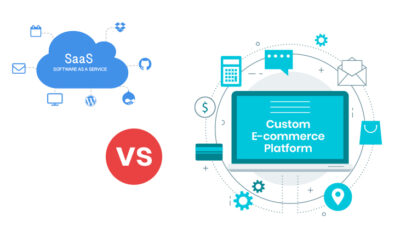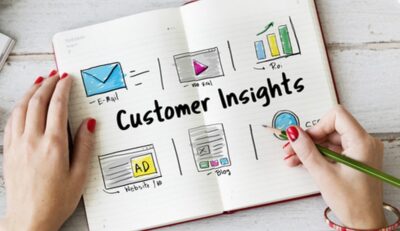Table of Contents
In today’s world of convenience, ecommerce is the answer to almost everything around retail and healthcare ecommerce should not be an exception. As technology continues to advance, more and more healthcare providers are turning to ecommerce to improve the patient experience and increase revenue. From online pharmacies to telemedicine, there are a variety of ways that ecommerce can benefit healthcare businesses of all sizes.

1. Healthcare Ecommerce Platforms
Setting up an ecommerce platform for your healthcare business has two main options: custom solutions and software as a service (SaaS) platforms. These terms may sound technical but the most important thing you should know is that both options have their pros and cons, and choosing the right one depends on your specific needs and budget.
Choosing the Right Platform
Custom solutions are built specifically for your business, which means they can be tailored to your unique requirements. However, they can be expensive and time-consuming to develop. Additionally, you will need to hire a team of developers to maintain and update the platform.
On the other hand, SaaS platforms are pre-built solutions that are hosted by the provider, making them easy to set up and maintain. They are typically more affordable than custom solutions, and many offer a range of features and integrations to help you manage your online store.
When choosing a platform, be sure to consider factors such as ease of use, scalability, security, and customer support. Look for a platform that offers the features you need, such as HIPAA-compliant data storage and secure payment processing. Custom solutions offer more flexibility and control, but they can be expensive and time-consuming to develop. SaaS platforms are easier to set up and maintain, but they may not offer the same level of customization.

Ultimately, the right choice depends on your specific needs and budget. If you have the resources and expertise to develop a custom solution, it may be the best option. However, if you’re looking for a more affordable and scalable solution, a SaaS platform may be the way to go.
2. Online Product Catalogue Management
Managing your online product catalogue is a crucial aspect of your healthcare ecommerce business. Your product catalogue is the foundation of your online store, and it needs to be accurate, up-to-date, and easy to navigate. Here are two key factors to consider when managing your online product catalogue:
Product Information Standards
Your product information needs to be standardized to ensure consistency across your catalog. This includes product names, descriptions, images, and other relevant information. Standardizing your product information makes it easier for customers to find what they’re looking for and helps you maintain a professional image.
One way to standardize your product information is to use a product information management system (PIM). A PIM is a software solution that centralizes your product information, making it easier to manage and update. With a PIM, you can create templates for your product information, ensuring that all products are listed consistently.
Catalogue Personalization
Personalizing your catalogue can help you stand out from the competition and improve the customer experience. By personalizing your catalogue, you can show customers products that are relevant to their interests and needs.
One way to personalize your catalogue is to use customer data to create targeted product recommendations. For example, if a customer has purchased a certain type of product in the past, you can recommend similar products to them.Another way to personalize your catalogue is to use customer feedback to improve your product listings. If customers are consistently asking for more information about a certain product, you can update the product listing to include that information.
3. Order Processing and Fulfillment

Efficient order processing and fulfilment is crucial for ensuring customer satisfaction and loyalty in healthcare ecommerce. Below are the two important aspects of order processing and fulfilment: secure payment processing and logistics and distribution.
Secure Payment Processing
In healthcare ecommerce, secure payment processing is essential to protect sensitive customer information and prevent fraudulent activities. You can use various payment processing platforms like PayPal, Stripe, Square, and others to ensure secure payment processing. These platforms offer robust security features like encryption and tokenization to keep customer data safe and secure.
In addition to using a secure payment processing platform, you should ensure your website is PCI-DSS compliant. The Payment Card Industry Data Security Standard (PCI-DSS) is a set of security standards that all organizations that accept credit card payments must follow. By complying with PCI-DSS, you can ensure that your website is secure and that your customers’ payment information is protected.
Logistics and Distribution
Logistics and distribution play a crucial role in healthcare ecommerce order fulfillment. You need to ensure that your products are delivered to your customers quickly, efficiently, and securely. You can use third-party logistics (3PL) providers like ShipBob, Speed Commerce, and others to handle your logistics and distribution needs.

These 3PL providers offer a wide range of services like warehousing, inventory management, order fulfilment, and shipping. By outsourcing your logistics and distribution needs to a 3PL provider, you can focus on growing your business and providing excellent customer service.
In summary, efficient order processing and fulfilment is crucial for the success of your healthcare ecommerce business. By using secure payment processing platforms and outsourcing your logistics and distribution needs to a reliable 3PL provider, you can ensure that your customers receive their orders quickly, efficiently, and securely.
4. Regulatory Compliance and Data Security
In healthcare ecommerce, regulatory compliance and data security are crucial factors that must be considered to ensure the protection of patients’ fundamental rights and maintain the integrity of the healthcare industry. HIPAA compliance and data protection laws are the two most important aspects of regulatory compliance and data security for the success of your healthcare ecommerce.
HIPAA Compliance
HIPAA (Health Insurance Portability and Accountability Act) is a federal law that sets the standards for protecting sensitive patient data. Healthcare organizations that deal with electronic protected health information (ePHI) must comply with HIPAA regulations to ensure the privacy and security of patients’ health information. HIPAA compliance requires healthcare organizations to implement administrative, physical, and technical safeguards to protect ePHI from unauthorized access, use, or disclosure.

To comply with HIPAA regulations, healthcare ecommerce organizations must conduct a risk analysis to identify potential vulnerabilities in their systems. They must also implement security measures such as access controls, encryption, and backup and recovery procedures to protect ePHI. Additionally, they must train their employees on HIPAA regulations and ensure that they follow proper security protocols when handling ePHI.
Data Protection Laws
Data protection laws are regulations that govern the collection, use, storage, and sharing of personal data. In healthcare ecommerce, data protection laws are important to ensure the privacy and security of patients’ personal information. Healthcare organizations must comply with data protection laws such as GDPR (General Data Protection Regulation) and CCPA (California Consumer Privacy Act) to protect patients’ personal data.
Healthcare ecommerce organizations must implement appropriate data protection measures such as encryption, access controls, and data retention policies to comply with data protection laws. They must also obtain patients’ consent before collecting and using their personal data and provide them with the right to access, correct, and delete their data. Additionally, they must ensure that their third-party vendors and service providers comply with data protection laws.
5. Marketing and Customer Engagement
In healthcare ecommerce, marketing and customer engagement are essential to attract and retain customers. Here are key strategies to improve your healthcare ecommerce marketing: content marketing and social media strategy.
Content Marketing
Content marketing has always been king. It involves creating and sharing valuable, relevant, and consistent content to attract and retain a clearly defined audience. In healthcare ecommerce, content marketing can be used to educate customers on health-related topics, provide product information, and establish your brand as a trusted source of information.

Creating effective content for healthcare ecommerce requires you to adequately understand your target audience’s needs and preferences. You can use keyword research to identify popular health-related topics and tailor your content accordingly. Consider creating blog posts, infographics, videos, and other types of content that are engaging and informative.
In addition to creating content, it is essential to promote it through various channels, such as social media, email marketing, and search engine optimization (SEO). By sharing your content on social media platforms, you can increase your reach and engagement with potential customers.
Social Media Strategy
Social media is a powerful tool for healthcare ecommerce marketing and customer engagement. By creating a social media strategy, you can build brand awareness, engage with customers, and drive traffic to your ecommerce site.
To create an effective social media strategy, it is essential to identify the social media platforms that your target audience uses most frequently. You can then create engaging content, such as product photos, customer testimonials, and health-related tips, to share on these platforms.
To maximize your social media engagement, consider using paid advertising to target specific audiences and increase your reach. You can also use social media analytics to track your performance and adjust your strategy accordingly.
6. Telehealth Integration
In the age of digital transformation, telehealth is becoming an increasingly popular way for healthcare providers to connect with patients. Telehealth services allow patients to receive care from the comfort of their own homes, which can save time and money compared to traditional in-person visits. In this section, we will explore two key areas of telehealth integration: virtual consultations and remote patient monitoring.

Virtual Consultations
Virtual consultations are a type of telehealth service that allows patients to connect with healthcare providers via video conferencing. During a virtual consultation, patients can discuss their symptoms, receive a diagnosis, and even receive a prescription if necessary. This type of telehealth service is particularly useful for patients who live in rural areas or have mobility issues that make it difficult to travel to a healthcare provider’s office hence it can be considered as a form of healthcare ecommerce.
Virtual consultations can also be more cost-effective than traditional in-person visits. According to a report by the American Hospital Association, telehealth services can help healthcare systems make more efficient use of limited staff and resources. The convenience telehealth offers equates to healthcare ecommerce, providing healthcare services at the convenience of patients or customers.
Remote Patient Monitoring
Remote patient monitoring is another type of telehealth service that allows healthcare providers to monitor patients’ health remotely. This can include tracking vital signs such as blood pressure and heart rate, as well as monitoring patients’ medication adherence. Remote patient monitoring can be particularly useful for patients with chronic conditions who require ongoing care.
Remote patient monitoring can also help healthcare providers identify potential health issues before they become serious. For example, if a patient’s blood pressure begins to rise, their healthcare provider can intervene early to prevent a more serious health issue from developing.
7. Analytics and Decision Support in Healthcare Ecommerce
Data analytics tools provide valuable insights into customer behavior, preferences, and trends. With the help of these tools, you can track customer interactions, monitor sales, and optimize marketing strategies. Some of the popular data analytics tools used in healthcare e-commerce include Google Analytics, IBM Watson Analytics, and Tableau.

Data Analytics Tools
Google Analytics is a free tool that allows you to track website traffic, user behavior, and conversion rates. You can use this tool to identify the most popular pages on your website, track the customer journey, and analyze the effectiveness of your marketing campaigns.
IBM Watson Analytics is a cloud-based tool that allows you to analyze large datasets and generate insights using natural language queries. With this tool, you can identify patterns, trends, and relationships in your data, and make data-driven decisions. Tableau is a data visualization tool that allows you to create interactive dashboards and reports. With this tool, you can explore your data, identify trends, and share insights with your team.
Customer Insights
Customer insights are critical for developing effective marketing strategies and improving the customer experience for your healthcare ecommerce business. By analyzing customer data, you can identify customer needs, preferences, and pain points. You can use this information to personalize your marketing messages, improve product recommendations, and optimize the customer journey. Some of the popular customer insights tools used in healthcare e-commerce include Qualtrics, SurveyMonkey, and Hotjar.
Qualtrics is a customer experience management tool that allows you to collect feedback from customers across multiple channels, including email, web, and mobile. With this tool, you can create surveys, analyze responses, and generate insights. SurveyMonkey is a survey tool that allows you to create and distribute surveys, analyze responses, and share insights. With this tool, you can collect feedback from customers, employees, and other stakeholders.

Hotjar is another customer feedback tool that allows you to track user behavior on your website, including clicks, scrolls, and mouse movements. With this tool, you can identify areas of your website that need improvement and optimize the customer journey.
In conclusion, as the world gravitates toward more and more convenience, healthcare ecommerce continues to grow its roots. As a healthcare providing looking to reach a wider range of customer with your products and services, healthcare ecommerce is a promising venture. However, it is crucial to adopt best practices for positive health outcomes of the target market, and for a good return on investment for your business.







